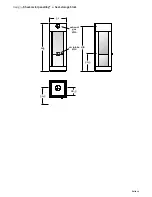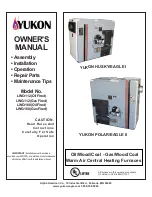
Seite 7
Suitable fuels
FireWood (LoGS)
Firewood (
Figure 4
) should have a moisture content of approx. 20 % of the dry
weight, a length of 1/3 m and should be split into small pieces. this way, the
firewood quickly catches fire and produces a higher heat output than the same
volume of large logs. spruce wood, fir wood or alder wood should be allowed
to dry out for at least 2 years, hardwood as long as 3 years (under a roofed
shelter).
the effect of the water content in wood on the calorific value is shown in
Tabe
1
:
Unsuitable fuels
Moist wood, bark waste, sawdust, fine wood chips, brushwood, wood-wool,
wood shavings. use paper only in small amounts to kindle a fire. the burning
of such fuels results in significant pollutant emissions, large amounts of ash,
and the heat output is comparatively low.
prohibited fuels
surface-treated wood (veneered, painted, impregnated, etc.), particle board,
all types of household waste (packaging waste), plastic materials, newspapers,
rubber, leather, textiles, etc.
Burning these materials is harmful to the environment and is therefore prohibi-
ted by law. Furthermore, damage to the appliance and the chimney can occur.
Furthermore the combustion of coal and similar fuels is not permitted. the ap-
pliance has not been tested for use with these fuels; therefore damage to the
appliance cannot be ruled out and is not covered by warranty.
7. Fuels
7. Fuels
Failure to observe these instructions will invali-
date any warranty!
Failure to observe these instructions will invali-
date any warranty!
Storage of wood
water content
%
calorific
value
kWh/kg
green wood
50
~2,3
stored for one winter
40
~2,7
stored for one summer
18-25
~3,4
air dried
15-20
~4,2
Figure 4
Tabe 1
8. Chimney / Flue pipe connection
8. Chimney / Flue pipe connection
The appliance must not be connected to a
shared flue system!
The appliance must not be connected to a
shared flue system!
The exhaust system must be inspected by the
local qualified chimney sweep before starting to
use the appliance.
The exhaust system must be inspected by the
local qualified chimney sweep before starting to
use the appliance.
•
For safe operation of the appliance an effective chimney height of at least
5 m (from the flue connection to the chimney outlet) is recommended.
•
For further information as regards the necessary minimum discharge pres-
sure see the technical details on
Page 17
, in our brochures and on the
nameplate.
•
please have the minimum discharge pressure checked by the local chimney
sweep!
Flue pipe connection
the flue pipe is the connection between the insert stove and the chimney.
When installing the flue, please note the following instructions:
•
the tHerMO Insert requires a 120 mm flue pipe.
•
the connection between the insert stove and the chimney must be strong
and leak-proof. In particular the connection to the masonry of the chimney
must be durable and tight.
•
Make sure that the connecting piece can be cleaned (cleaning opening).
•
the diameter of the flue pipe must not decrease towards the chimney.
•
the flue pipe must not project into the chimney.
•
Vertically positioned flue pipes must not exceed a length of 125 cm if they
are not insulated.
•
Horizontal pipe sections must not exceed a length of 100 cm.
•
the flue pipe must not descend towards the chimney, but must incline
slightly upward.
Chimney flue connection independent of indoor air
(room-sealed
appliance)
If the appliance is operated independently of indoor air, the following instruc-
tions are also to be observed:
•
the chimney flue must be sealed at the pipe connection by means of a
temperature resistant sealant.
•
the flue pipe must have a gas-proof connection to the chimney and must
be sealed by means of an appropriate rope seal and a temperature resistant
sealant (e.g. heat-resistant silicone).
The total length of the connecting pipe between
appliance and chimney should not exceed 1.5 m.
The total length of the connecting pipe between
appliance and chimney should not exceed 1.5 m.






































